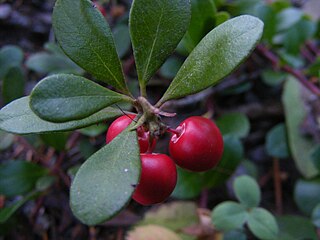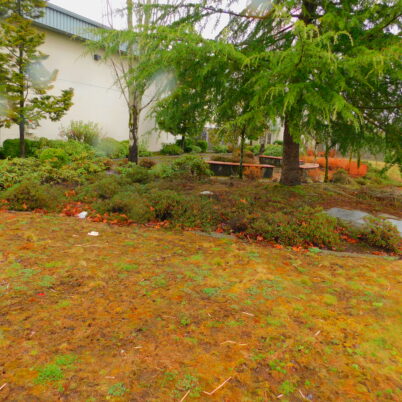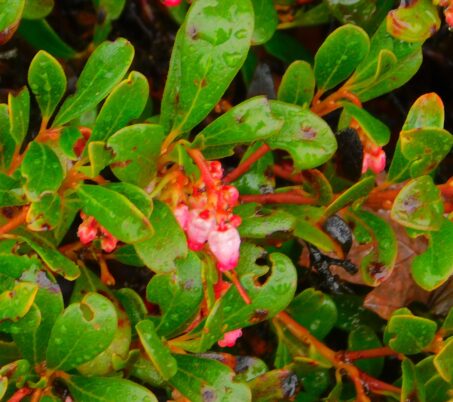If you give a bear a grape…
Marcia Wilson

One of the smallest, least-noticed native wildflower is now thriving on the Lakewood campus. Small, however, does not mean unimportant…
The plant:
- Arctostaphylos uva-ursi (Latin)
- Translation: Bear-grape, bear-grape
- Bearberry, common name in Scotland, Ireland, Britain and Wales
- Kinnickinnik
- Lushootseed: k̓ayuk̓ayu
- “sac-a-commis (French trapper)
- Mealberry (the fruit’s texture is dry and mealy)
- Mountain-box (leaves like boxwood)
- Barren myrtle (same)
- “Crane food” (Chipewa, délhni)
- Netene, Slavey language
- In English: mealberry, sandberry (many others, including: mountain-box, universe-vine, rapper-dandies, fox-plum, hog-crawberry, barren myrtle)
- In French:
- bousserole,
- raisin d’ours = grape of the bear
- sac-a-commis
- German: Variations of bearberry, but also, Moosebeerenblätter, mooseberryleaf
- In Chipewyan: délhni (“crane food” = berries)
- In Cree: muskominanatik (=berry), kinnikinnick (=leaves)

Why is it here
It was already in the Pacific Northwest to begin with, and xeriscaping, the act of landscaping with native plants that are already suited for the worst the climate has to offer, makes sense.
The decision to plant Arctostyphalos uva-ursi upon the campus grounds was a smart one. This little native is almost unbelievably hardy once it establishes its tough, wiry roots into the earth. It is a vivid evergreen year-round. Its water needs are minimal in summer, and it provides a useful groundcover that keeps the soils cooler and ameliorates the stress of high temperatures. It protects the soil from loss by erosion, and it a sharp, deep green pleasing to the eye.
To be fair, its popularity is more to its usefulness in history’s medicine-cabinet than its hearty good looks.
Cold-natured, and for good reason.
The earliest found uva-ursi fossil dates from the Middle Miocene Epoch. This period lasted from approximately 16 Ma – 12 Ma, and oversaw a drastic drop in temperature that badly impacted many floral and faunal life forms. The hardly little plant thrived and has continued through millions of years of climate shift.
For perspective, this little herb emerged on Earth at the same time as dogs, horses, and bears. More about bears later.
Native, but where?
Uva-ursi remains in North America in the cooler climes, Europe, and Asia. Its healthy presence is a confident indicator that the ecosystem went through a recent glacial retreat. “Recent” of course being a comparative word in geology.
Pacific northwest
Unlike a lot of temperate plants, uva-ursi can handle the crushing levels of precipitation in the Puget Sound’s winters, and hold steady against the equally stressful summers with long, dry heat. The adaptability for diametrically opposed seasons is its key to survival. In a world of “boom or bust” the Uva-ursi makes do with what it has. Wildlife depends on its presence as a low-ground shelter and as a long-lasting fruit. Dry and mealy in nature and occasionally forming in small clusters, the red berries need cooking and processing before humans consider it tasty. Animals are less discerning. Bears particularly love the fruits and this has a lot to do with why its Latin name references bears twice.
Living medicine chest
Stone Age digs prove earlier humans kept uva-ursi with them; charred remnants have been found in Neolithic sites. Besides the usefulness of having a berry that stores well, the leaves and blossoms were used for a myriad of illnesses. Primarily, Urinary Tract Infections/Cystitis, and astringent washes for cankers, cold sores, and skin. To say the leaves are astringent is an understatement. Biting down on a raw leaf is enough to make a person feel as though all the moisture in their mouth is running away from the acrid juices. It is dry and bitter, not unlike biting down on a bag of very sharp black tea leaves.
Put that in your pipe and smoke it

Uva-ursi’s better known name, kinnikinnick, derives from a broad Eastern Woodland word for “mixture” used for smoking. This encompasses many possible plant mixtures of which uva-ursi was a vital part. It would be too easy to over-generalize and miss nuance and ethnic/cultural terms. Think of it as a definition similar to gumbo: there are many different variations, all valid, but if gumbo must contain sassafras leaf to be considered authentic, most forms of kinnikinnik contains uva-ursi to be an historically authentic smoking blend for many regions.
The French trapper’s name for the plant, sac-a-commis means clerk bag because they noticed the clerks in charge of paperwork, payroll, and who gave them the money for their skins were always walking around with little bags of kinnikinnick around their necks. It may be just a coincidence that the tiny white blossoms look like little pouches, but it is worth mentioning.
Perfectly paired
Uva-ursi is an anthropogene. It likes the types of disturbed soils left by humans. Perhaps this ensured the relationship between the two, perhaps not. Either way, humans are still learning a great deal about the plant and its complex chemical compounds that hold promise for pharmacological applications. It holds phenolic compounds, arbutrin, disinfectants and antibacterial agents. That said, do not harvest this plant for casual use; like any herb one should consult with a medical professional first. The uva ursi on campus is exposed to pollution and sprays, so stick to admiring it for its beauty.